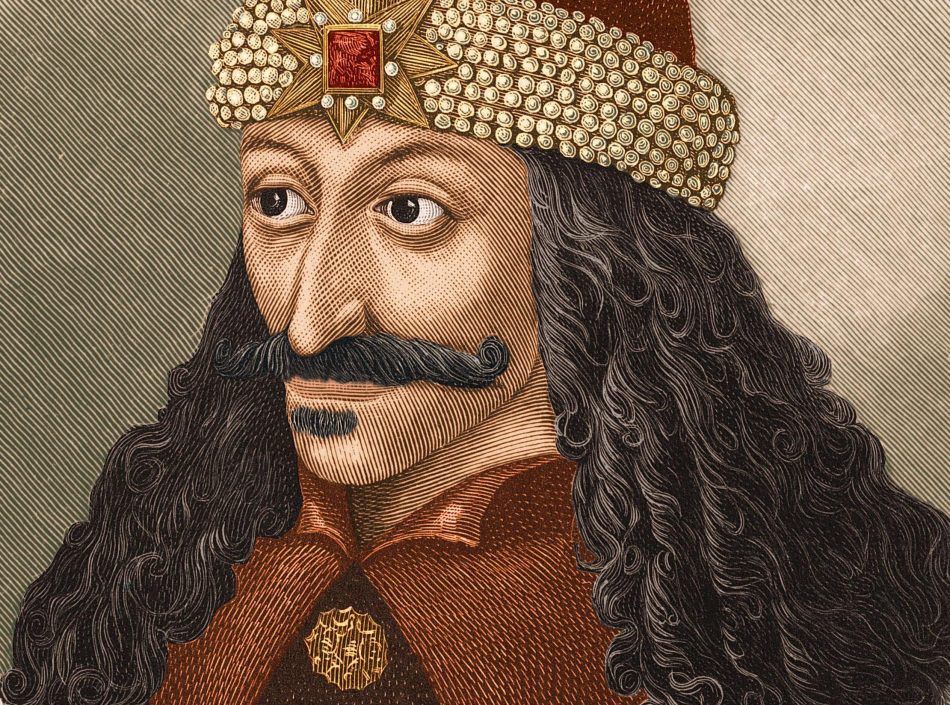[su_youtube url=”https://www.youtube.com/watch?v=R0_7Sl7E3ys”]
Elizabeth Miller, President of the Transylvanian Society of Dracula’s Canadian chapter, discusses a popular misconception about Vlad Dracula (1431–1476) in this clip from a Dracula documentary.
Count Dracula’s name was taken from Vlad Dracula, voivode of Wallachia. While Bram Stoker was writing and researching Dracula (1897), he found references to Dracula in William Wilkinson’s An Account of the Principalities of Wallachia and Moldavia: with Various Political Observations Relating to Them (1820) and substituted his vampire’s name (“Count Wampyr”) with Dracula.
But apart from their names, they don’t share much else in common—except for an appetite for human blood. Or so the story goes.
You’ve probably heard it before: Vlad Dracula dipped bread in the blood of people he impaled. That means he was a vampire after all! Not so fast: the claim originates with Raymond T. McNally (1931–2002) and Radu Florescu (1925–2014), two Dracula scholars, who kicked the whole thing off in their book In Search of Dracula: The History of Dracula and Vampires (Boston: Houghton Mifflin Company, 1994):
The German writers [of Vlad Dracula pamphlets] relate that aside from impaling his victims, Dracula decapitated them; cut off noses, ears, sexual organs, limbs; hacked them to pieces; and burned, boiled, roasted, skilled, nailed, and buried them alive. In one verse [Michael] Beheim described Dracula as dipping his bread in the blood of his victims, which technically makes him a living vampire — a reference that may have induced Stoker to make use of this term. (p. 85)
Michael Beheim (1416–c. 1472) was the author of Von ainem wutrich der heis Trakle waida von der Walachei (1463), the poem that supposedly documented Vlad’s sanguinary tastes. If Stoker was aware of the poem, we have no evidence; it was not documented in his working notes, unlike many other works. But even if he was, it wouldn’t have mattered: McNally and Florescu misrepresented what Beheim said in the poem.
Elizabeth Miller and David B Dickens reassessed McNally and Florescu’s claim in a joint Journal of Dracula Studies paper called “Michel Beheim, German Meistergesang, and Dracula” (2003). They did something many authors who’ve regurgitated McNally and Florescu’s claims haven’t bothered to do: double-check Beheim’s poem. By doing that, they produced a translation that cleared the matter once and for all:
It was his pleasure and gave him courage
To see human blood flow
And it was his custom
To wash his hands in it
As it was brought to the table.
As Matthew Beresford says in his book From Demons to Dracula: The Creation of the Modern Vampire Myth (London: Reaktion Books, 2008): “So Dracula washed his hands in the blood, not dipped his bread in it, if, indeed this is a literal account of what happened” (p. 92), adding:
Often the metaphorical terms ‘bathing in the blood of the enemy’ or ‘washing your hands in blood’ (hence the phrase ‘blood-bath’) are applied to suggest some guilt or blame in a given situation usually involving the spilling of blood, and are not representative of actual washing or bathing in blood. Given Dracula’s bloodthirsty (again, not indicative of the consumption of blood!) manner it would not be surprising if he did indeed wash his hands in the blood, but either way, this does not constitute an act of ‘vampirism’. And this is the entire evidence concerning Dracula and blood-drinking found in the historical documentation.
That’s right: Beheim’s poem was it. The only “evidence” Vlad was a bloodsucker. So much for that! When Stoker has Van Helsing say “In the records are such words as ‘stregoica’ witch, ‘ordog’ and ‘pokol’ Satan and hell, and in one manuscript this very Dracula is spoken of as ‘wampyr,’ which we all understand too well,” he was making it all up; after all, he was writing a novel, not a history book. Vlad would probably be spinning his grave if he knew he’d been turned into a vampire.
This article was inspired by Erin’s thread on the Count Dracula Facebook group. Writers should double-check the original sources wherever possible, which I discussed in my Diary of an Amateur Vampirologist blog post, “The Importance of Paper Trails” (Sept. 1, 2010).
Miller and Dickens’ paper was originally published in the Journal of Dracula Studies, no. 5 (2003): 27–34. You can read an .rtf version here. I also highly recommend reading Miller’s book, Dracula: Sense & Nonsense (2000; 2006) for other “myths” that have sprung up about Stoker’s creation.
If you want to join the Transylvanian Society of Dracula’s Canadian branch, the “international, non-profit organization dedicated to the study of both Count Dracula of fiction and Vlad (Tepes) Dracula of history,” click here. I’m a member, too. Trust me: it’s worth it.

Good job on this. I even saw the bread-dipping thing on a TV documentary not too long ago. As my son says, “ALWAYS check your references”.
Thank you, K.R. Yes, the bread-dipping myth still persists! And your son is a wise man. 🙂
Brilliant article as usual Anthony! I love how Elizabeth discusses the dangers of things being translated loosely or incorrectly. Another example of how important accurate citations and translations are in an academic sense. I always enjoy how you take the research a step further! You continue to impress me 😀
Agreed, Erin and it was one hell of a “mistranslation,” at that! Perhaps McNally and Florescu translated what they wanted to see? All the same, yes: writers should double-check their sources wherever possible!
What do you think about this prank? https://www.fiverr.com/s/7kcgyn
I think that’s brilliant!
Wait a second, you cheeky bugger…that’s you! Your prank! And it doesn’t seem so much a prank as a sneaky way to make cash.